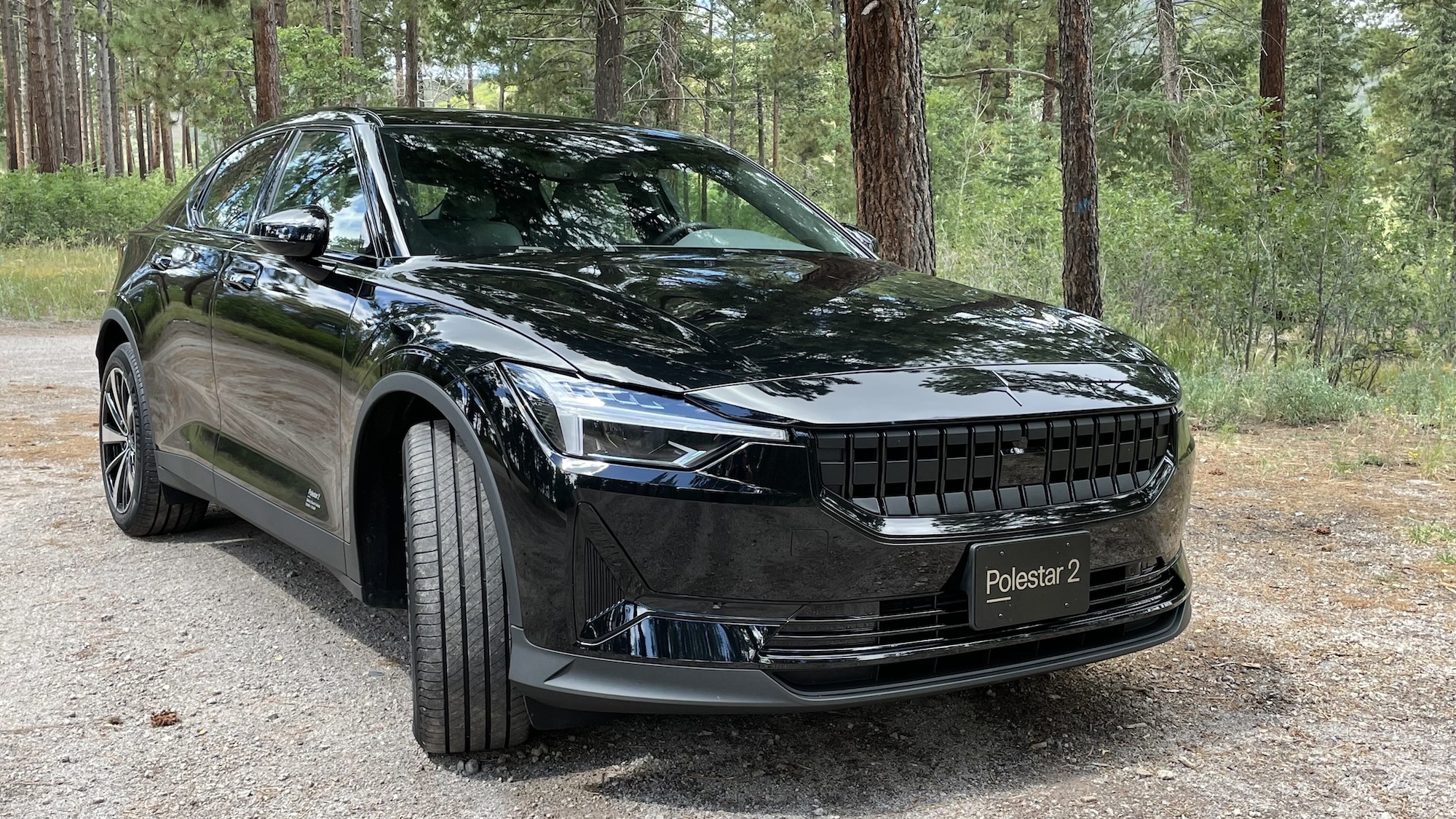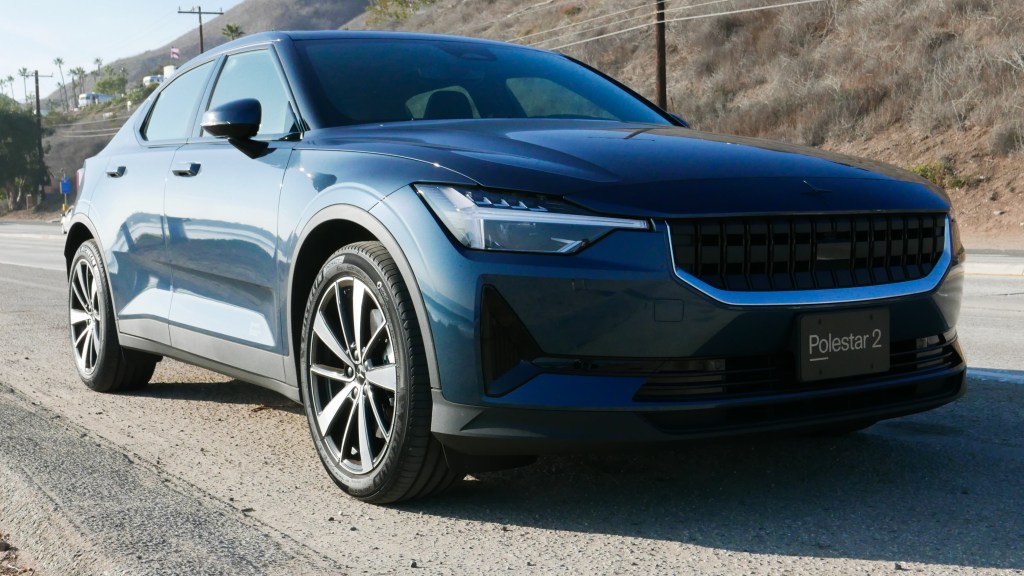When Polestar launched its first all-electric vehicle last year, it came in a single flavor: a dual-motor, all-wheel-drive configuration that cost around $50,000 before incentives. Next year, the automaker is adding some variety.
Polestar is rolling out a more affordable, single-motor, two-wheel-drive version of the sedan that still offers many of the features of the dual-motor Polestar 2 along with a few changes that make it a bit more affordable, appealing and greener for those looking to make the electric switch. In a recent drive, we put it to the test.
Single or dual motor

The 2022 Polestar 2 single motor offers a Polestar-estimated 270 miles of range, a bit less oomph and fewer options yet plenty of technology to make your drive easier.
Rather than having two motors that power all four wheels — like it does with the dual motor — this single-motor version pushes all its 231 horsepower and 243 pound-feet of torque to the front wheels. The 2022 Polestar 2 single motor comes with a 78 kWh battery pack that sits under the floor between the front and rear wheels. Polestar says that its usable capacity is 75 kWh. The same battery pack is in the Polestar 2 dual motor. Polestar can and has pushed over-the-air updates to all of its vehicles to help make charging faster and tweak battery settings to make them more efficient.
The 2022 Polestar 2 Single motor sedans also get the optional addition of a mechanical heat pump (available in the Plus Pack for $4,000 more) that helps maintain that charge in more adverse climates. Polestar says that under certain climate conditions the heat pump will scavenge heat from the outside air to extend the range of the vehicle by as much as 10%. Using Polestar’s estimate, that means that the 2022 Polestar 2 Single motor could gain an additional 27 miles of range thanks to the heat pump.
For this model year, the fully loaded Launch Edition has been eliminated. The Polestar 2 Single motor replaces it and comes with a simplified and less loaded setup including a metal roof instead of the Launch Edition’s glass one, environmentally-friendly upholstery and a choice of a handful of option “packs,” as Polestar calls them.
You can opt for the Plus Pack, which includes the heat pump, a glass panoramic roof, Harman Kardon premium audio and a wireless phone charger (amongst other things). This pack was on the prototype Polestar 2 I drove. You can also opt for the the Pilot Pack ($3,200 more) that includes things like adaptive cruise control and LED exterior lighting. Sadly, the vehicle I drove did not have the upgraded ADAS system so I was not able to test out what Polestar says offers Level 2 driver support aids on my drive.
Native Android OS and OTA updates

The Polestar 2 has the distinction of being the first vehicle to use Google’s Android Automotive operating system. While Volvo has also rolled out the Android Automotive OS in some of its vehicles like the Volvo XC40 Recharge, the entire Polestar brand uses the platform.
Android Automotive OS is an open source operating system that runs on Linux and is used as the underlying operating system in vehicle infotainment systems, including Polestar. As a result, Google services such as Google Assistant, Google Maps and the Google Play Store are embedded into the car. Android OS is not the same as Android Auto, a secondary interface that lies on top of an operating system and lets users project the functions and feel of their smartphone to the vehicle’s center display.
In the 2022 Polestar 2, users can choose to access almost everything in the vehicle via voice control by using the convenient “Hey Google,” initiation phrase. This phrase gets you access to climate control and driving directions. Since the public has been so deeply steeped in the Google infrastructure for so long now, it’s all highly intuitive.
Tell the system your feet are hot and Google OS will lower the temperature in the footwell. Want to find the best taco place in Santa Barbara? Just ask Google to search then navigate there like I did. I rarely touched the touchscreen while driving, as I could pretty much do everything I needed just by asking Google to do it for me.
Natural language recognition is something Google has been working on diligently for many years and it keeps getting better. A few times, when using the system, I botched a request or awkwardly asked for something like adding a stop at a local beach to take photos. The system didn’t miss a beat and untangled my language to do just what I asked it to do.
In the Polestar 2 Single motor I drove, charging locations were somewhat integrated to the Google Maps platform on Android OS. There are some caveats, however.
Ask Google to find charging stations along your route, and you can filter by brand. While doing so in Google Maps, the system won’t tell you if a charger is available or working. Polestar has partnered with ChargePoint to provide charging access, and you can use the ChargePoint App, installed on the center screen, to learn more about your selected charger. It does take some tapping around the screen before hitting the road, which means you’ll still need to pull over and stop before heading to the nearest charger. On my 200-mile roundtrip from the Pacific Design Center in Hollywood to Santa Barbara I didn’t need to stop to recharge.
If I had needed to recharge, Polestar says that on DC fast chargers, I could have expected to get to 80% charge in just about 30 minutes. That’s down from the 40 minutes it used to take to get to an 80% charge, according to Glenn Parker, a Polestar technical operations specialist. Parker also said that continued over-the-air updates will improve the efficiency and range of the entire portfolio as the company rolls out updates to all owners.
While finding an available charger is still clunky, the integration of Google Maps into the very technological fabric of the Polestar 2 means that your estimated range is displayed each time you navigate to a new place or add a stop along the way. On my day trip, I arrived at each destination with a few miles more range than the system originally thought I’d have, which was a nice surprise given that I timed my return to LA badly and sat in Westside traffic for 45 minutes, while the range hovered down around 20%.
On the road

The Polestar 2 Single motor is quiet, comfortable and quick. Polestar says that it does 0 to 60 mph in seven seconds, and while that doesn’t seem like much, it’s plenty to get you merged into traffic on the highway, especially because the low-end torque is so readily available.
On the prototype I drove, I could adjust a few driving features, including steering feel and one-pedal braking and could toggle some of the driver assistance systems like lane departure warning on and off. Unfortunately, as previously mentioned, my test vehicle did not have any of the advanced driver aids that Polestar offers in the Pilot pack so I didn’t get to test those.
One of the joys of electric vehicles is the availability of braking mode (B Mode), or one-pedal driving. Essentially you’re adjusting the level of regeneration you get from the rolling wheels when you lift off the accelerator.
In the Polestar 2, you can roll to a stop, or toggle on the “Creep” mode setting through the infotainment screen and the vehicle will move slowly without the accelerator pedal being necessary. I drive most electric vehicles with the most aggressive braking setting, as it’s the most efficient and most enjoyable mode to employ in Los Angeles traffic. While most people may find the highest setting in the Polestar 2 to be a bit surprising, after a few minutes of getting used to it, it becomes intuitive to use. I did however turn off the “Creep” function as it felt unnatural when paired with the regenerative braking mode.
I also spent 90% of my time behind the wheel using the most aggressive steering setting, called “Firm.” Essentially the system changes the steering ratio based on the setting you’ve chosen. Firm offers the most direct-feeling response, while the softer settings make the Polestar feel a bit more roly-poly and slow to respond.
Right to repair, recondition, recycle
Polestar makes no bones about its commitment to greener manufacturing and materials. To that end, the company is proactively considering the entire lifecycle of the batteries in its vehicles. According to Parker, the company uses blockchain to track the mining of cobalt for its batteries and is looking into using the system to track other elements used in building their vehicles.
In addition to this, Polestar has also thought relatively comprehensively about the battery and owner lifecycle.
The stacked packs in the Polestar 2 Single motor can be individually replaced as parts fail. Parker said that if one component fails, the company collects that material back to form a closed-loop system. “We’re exploring remanufacturing and reusing those components that come back,” he said. Polestar also offers complete repair instruction and access to a catalog of parts that owners can purchase directly from the company itself, too.
Prices for the Polestar 2 Single motor start at $45,900 and vehicles will be available starting January 2022, not including the destination fee or taxes. With the $7,500 federal tax incentive — as well as incentives from certain states — that price can come down to around $35,000 (again not including taxes and the destination fee).































Comment